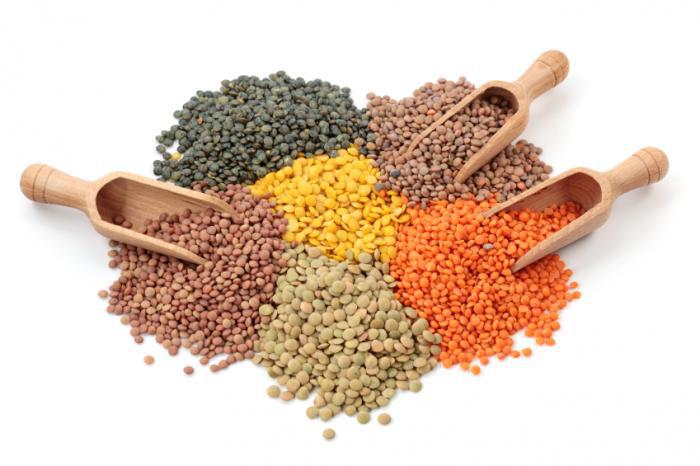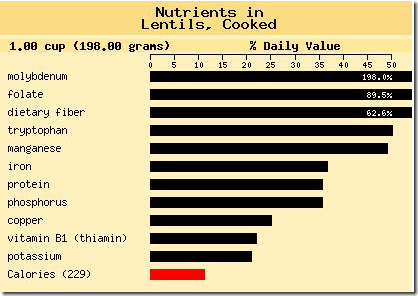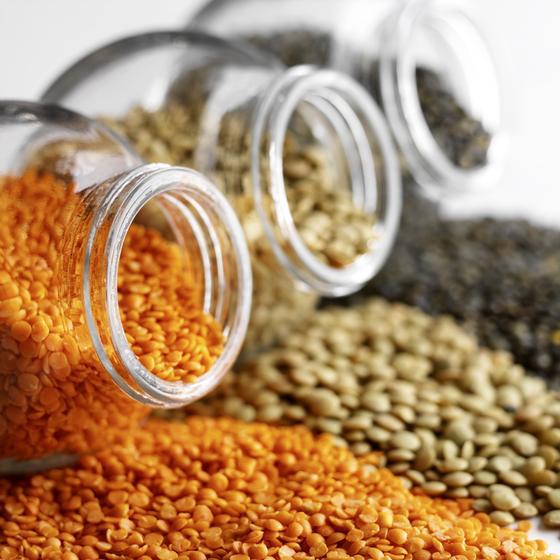Lentils, one of the world's culinary powerhouses...


Lentils are legumes (along with other types of beans) that grow in pods that containin one or two lentil seeds that are round, oval or heart-shaped disks.
Compared to other types of dried beans, lentils are relatively quick and easy to prepare, they readily absorb a variety of wonderful flavors from other foods and seasonings, are available throughout the year, and are one of the world's healthiest foods.
Lentils are a great source of cholesterol-lowering fiber, are of special benefit in managing blood-sugar disorders (ie Diabetes) since their high fiber content prevents blood sugar levels from rising rapidly after a meal, and they provide good to excellent amounts of seven important minerals, B-vitamins, and are extremely high in protein. When combined with grains (wheat, rice, etc) the resulting dish is a complete protein – meaning that it contains all nine essential amino acids in the correct proportions for supporting human biologic functions!
All of this nutritional goodness with virtually no fat - Just 229 calories for a whole cup of cooked lentils!
There are literally hundreds of varieties of lentils available in nearly every color of the rainbow but they can be broken into three general categories:
Brown Lentils:
By far the most common variety of lentil found pretty much everywhere that lentils are sold. They range in color from khaki-brown to dark black, and generally have a mild earthy flavor, cook in about 20-30 minutes, and hold their shape very well.
Common brown lentil varieties include Spanish Brown, German Brown, Indian Brown, and the prized tiny, black Beluga lentils
which have a rich and deeply earthy flavor and 'glisten like beluga caviar' when cooked which gives them their name.
Green Lentils:
Green lentils can be pale or mottled green-brown in color with a glossy exterior and they have a robust, somewhat peppery flavor. Green lentil varieties generally take the longest to cook (upwards of 45 minutes) but they keep a firm texture even after cooking which makes them ideal for salads and other side dishes.
Common green lentil varieties include French Green Lentils, Indian Green/Yellow Lentils
(Moong), and the prized Lentilles du Puy.
Red Lentils:
With colors ranging from gold to orange to actual red, these are the sweetest and nuttiest of all the lentil varieties. Red lentil varieties fall somewhere in the middle in terms of cooking time (usually done in around 30 minutes). Red varieties tend to get mushy when cooked through making them perfect for Indian dals and other 'curries', or for thickening soups.
A few common varieties include Red Chief, Crimson, and in Indian or Middle Eastern markets, Masoor
and Chana
dals.


Lentils are believed to have originated in central Asia where they have been consumed since prehistoric times. They are one of the first foods to have ever been cultivated - Lentil seeds dating back more than 8000 years have been found at archaeological sites in the Middle East! Lentils were introduced to India sometime before the 1st century BCE where they remain a staple in the cuisine to this day.
Throughout the world, lentils are prized for their versatility and are the cornerstone of many of the world's cuisines where they are used in soups and stews, eaten in salads, are turned into flour to make breads, batters, cakes, and utilized as a thickener, they are even sprouted and eaten raw or cooked into all types of dishes. Most surprisingly, there are a huge variety of sweets made from lentils or lentil flour including India's Imarti, Jaangiri, and Pinni
to name but a few.

INTERESTING FACT:
When discussing the cuisine of India, the word 'Dal'
is commonly used as a generic term for lentils and other pulses (all other beans) or the dishes made from either; however, in reality, the word 'Dal' technically
refers ONLY to the split version of a number of lentils, peas, chickpeas (chana), kidney beans, etc and the dishes made from these 'true' dal. If a pulse is split into half, it is a dal. This fact leads to the common distinction of 'Indian Dals' in many writings.
Lentilles du Puy
Of all of the lentil types available, there is really only one variety that stands alone. Claimed by chefs and foodies as the premium elite, praised as being superior in both flavor and texture, and touted as the best there is - Lentilles du Puy.
Lentilles (Verte) du Puy
or the Le Puy Green Lentil
is a very specific, 'special' variety of lentil grown in the rugged, mountainous region of Auvergne in the South of France near the commune (read: township) of Le Puy-en-Velay. These lentils are grown in rich volcanic soil without fertilizing or irrigation (relying only on rain fall and other naturally occurring moisture) which gives them a unique flavor and nutritional value; Most describe the flavor as 'fine, nutty, earthy, slightly flinty with a slight mineral edge'.
These beautiful little lentils are mottled with green and blue coloration and are packed with flavor, take less time to cook, and hold their shape better than 'ordinary' lentils. Le Puy Lentils have a firmer texture and contain less starch than 'ordinary' lentils which means they don't get as 'mushy' when cooked and don't make soups 'muddy'.
These extremely versatile little wonders are equally good served either warm or at room temperature and can be used in almost any type of dish from soups and stews to salads and even as a paste to accompany fish or lamb.
Lentilles du Puy
are considered a premium product and are priced as such; costing up to three times that of 'ordinary' lentils. As already stated, they are considered vastly superior to the 'ordinary' French Green Lentil in both flavor and texture and are regarded a regional treasure that deserves protection. As such, Lentilles du Puy have been given Protected Designation of Origin
(PDO) by the European Union and Appellation d'Origine Contrôlée
(AOC) in France which translates as 'Controlled Designation of Origin'.
These certifications guarantee that ONLY lentils from the region of Le Puy France can be named as such and are given based on Terroir (most commonly heard associated with wines) that presumes that the land and conditions where the product is grown imparts a unique quality that is specific to that growing site. These certifications are meant to protect the reputation of regional foods, promote rural and agricultural activity, help producers obtain a premium price for authentic products, and eliminate unfair competition and the misleading of consumers by non-genuine products that may be inferior or of a different flavor.

When buying Lentilles du Puy, look for the AOC/PDO seal on the package to ensure that you are getting the genuine article and not an 'inferior' imposter variety.
Lentilles du Puy may be known to some as green pearls, poor man's caviar, or le caviar végétal but no matter how 'special' people may make them sound, are they really worth seeking out? The truth is, it is really up to the individual and no matter what I (or others) say can make up your mind for you - you have to try them for yourself. Chefs, foodies, the European Union, and the French Government praise these lentils as if they are VASTLY different than all the others and superior in almost every way BUT, that opinion (like every opinion) varies from one individual to another so it is up to YOU as the individual spending their money and eventually eating them to decide if they are worth it to YOU.
I DO suggest that you give Lentilles du Puy a try and judge for yourself!
Regardless of the type(s) of lentil(s) you purchase and ultimately use in your culinary preparations, don't overlook these tiny, culinary powerhouses! If you have not already, give these versatile legumes a chance and add them to your kitchen repertoire - Just remember, in much of the world (India in particular) no meal is complete without at least one dish made with lentils; PLUS science has proven that people with diets rich in legumes are less likely to suffer cardiovascular disease so go and EAT IN HEALTH and make some lentils!

